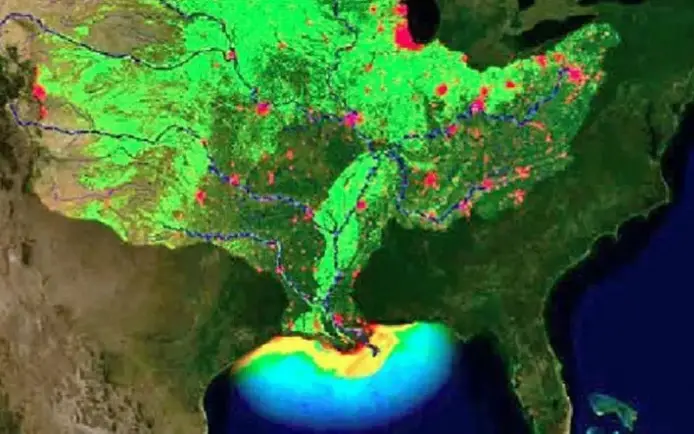
Photo via NOAA
Each year, a familiar-yet-demoralizing sight appears on the horizon as researchers study the Gulf of Mexico, the 617,800-square mile salt water area stretching from Florida to Louisiana and the Texas coast line: the annual “dead zone.”
The area, which has already been hit hard by chemicals sprayed in the aftermath of the April 2010 BP oil disaster over the years, has becoming increasing polluted over the years, and now things are about to take a turn for the worse, according to researchers at Louisiana State University, as the Gulf of Mexico’s 2019 dead zone is expected to be the second-largest on record.
Gulf of Mexico Dead Zone to Hit Near-Record Levels
The researchers’ prediction for the 2019 dead zone is startling to say the least — its size is expected to be about 8,717 square miles, an area roughly the size of New Hampshire.
That would place it just short of the record of 8,776 square miles set in 2017, and far above the average size at 5,309 square miles.
A dead zone occurs at the bottom of a body of water when there isn’t enough oxygen in the water to support marine life, a report from USA Today said. The process is know as hypoxia and it is created by nutrient runoff, mostly from the overapplication of fertilizer on agricultural fields during the spring, the article noted.
Tyson Foods, GMO Corn Among the Culprits
In October 2017, the website EcoWatch shared a report on an investigation from the Mighty Earth global campaign organization, which conducted a comprehensive study into which areas of the United States are experiencing the worst water contamination from fertilizer pollution.
The groundbreaking research identified the agricultural and meat industry corporations most present in areas where pollution was present, and found the “clear culprit” according to the report: Tyson Foods, the world’s second largest processor of chicken, beef and pork.
According to EcoWatch, Tyson could do the following to prevent fertilizer from contaminating the water:
-Use more precise application methods
-Use cover crops
-Diversifying crops beyond (mostly GMO) corn and soy
-Limiting tillage to reduce soil erosion
“(Tyson is) uniquely placed to drive solutions, incentivize their suppliers to farm more responsibly, and reduce the catastrophic effects that industrial-scale agriculture has on the environment and public health,” the Ecowatch report said.
Employing these and similar techniques practiced in organic and biodynamic farming could help prevent this type of massive, wide-scale pollution, but most companies like Tyson Foods are still fully on board with the “modern” methods of using GMOs and harsh, toxic chemicals like glyphosate from Monsanto and Bayer.
Currently, less than 30 percent of fertilizer applied to industrial agricultural fields is actually absorbed by the plant, leading to an overabundance of runoff that is destroying aquatic ecosystems from Lake Erie all the way down to the Gulf.
“Dead Zone” Trend Shows Little Signs of Slowing
Despite increasing public awareness of the Gulf of Mexico “dead zone,” the long-term trend shows no signs of slowing, according to University of Michigan aquatic ecologist Don Scavia.
“While this year’s zone will be larger than usual because of the flooding, the long-term trend is still not changing,” he said in a statement. “The bottom line is that we will never reach the dead zone reduction target of 1,900 square miles until more serious actions are taken to reduce the loss of Midwest fertilizers into the Mississippi River system.”
Last month, the National Oceanic and Atmospheric Administration said that fertilizer discharge (from factory farms) in the Mississippi system was about 67% above the long-term average.
Needless to say, we all need to change our ways to prevent this problem from becoming an even bigger catastrophe than it already has become.
Boycotting Tyson Foods and other factory farming mega-corporations while supporting local, sustainable organic and biodynamic agriculture is a good place to start.
Thanks for reading!
P.S. Check out The Human Longevity Project, airing from June 19-27, 2019…For the final time ever! This ground-breaking docu-series interviews the world’s longest living people to discover their secrets.
Click here to reserve your spot and watch for free!!!
Thanks for installing the Bottom of every post plugin by Corey Salzano. Contact me if you need custom WordPress plugins or website design.





